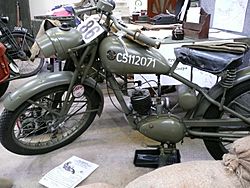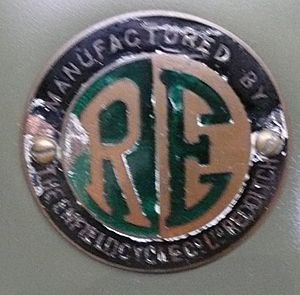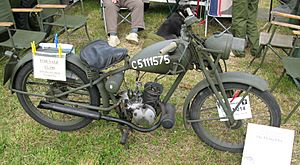Royal Enfield WD/RE facts for kids
 |
|
| Manufacturer | Royal Enfield |
|---|---|
| Also called | Flying Flea |
| Production | 1939–1945 |
| Predecessor | DKW RT100 |
| Successor | RE125 |
| Class | Military |
| Engine | 126 cc air-cooled two stroke single |
| Top speed | 45 mph |
| Power | 3.5 hp @ 4,500 |
| Transmission | three-speed, chain final drive |
| Suspension | fixed |
| Brakes | drum |
| Dimensions | L: 75 in W: 26 in |
| Weight | 130 lb (59 kg) (wet) |
| Fuel consumption | 130 mpg (2.1L/100km) |
| Related | RT 125 |
The Royal Enfield WD/RE, also known as the "Flying Flea", was a small, light motorcycle. It was made by Royal Enfield in the United Kingdom. This special bike was designed for the British War Office during World War II. Its main job was to carry messages quickly. Soldiers could drop it by parachute or carry it in gliders. This helped connect airborne troops with others when radios didn't work.
Contents
How the Flying Flea Was Developed
The Royal Enfield WD/RE 125 cc motorcycle became very famous during the Second World War. People called it the Flying Flea. It was specially made to be dropped from planes with paratroopers.
Starting the Design
Before the war, a company in the Netherlands imported DKW RT100 motorcycles. When Germany stopped their supplies in 1938, they asked Royal Enfield for help. Royal Enfield decided to make a similar motorcycle. Ted Pardoe designed their version, making the engine a bit bigger.
Two early versions, called 'Royal Baby', were shown in April 1939. These bikes used a simpler, larger two-stroke engine. A few were made before the Second World War began.
Royal Enfield's War Effort
Like other British motorcycle makers, Royal Enfield started making bikes for the war. They produced different military motorcycles. These included the Royal Enfield WD/C and WD/D models.
In early 1942, the War Office ordered twenty WD/RE motorcycles for testing. These bikes were based on a civilian design from 1939. They had a right-hand brake and an Amal carburettor.
Making the Flea Ready for War
The tests went well, leading to some changes. The bike got a special exhaust system to make the noisy two-stroke engine quieter. It also received a Villiers carburettor.
Other changes included moving the toolbox higher. The kick-start, footrests, and handlebars could now fold. This helped pack the bike into a very small space. A lighting system was added, along with a special fuel cap. This cap stopped fuel from spilling when the motorcycle was packed for dropping. The foot brake was also moved to the left side.
The War Office needed a very light motorcycle to help soldiers communicate. Paratroopers often landed far from main forces or out of radio range. The big challenge was making sure the bike landed safely after being dropped.
In the summer of 1942, engineers started working on a protective frame. This frame would go all around the motorcycle. They tested different designs by dropping them from bombers like the Halifax. The frames needed to protect the bike and be easy to remove.
At first, the frames were too light and bent the wheels when they landed. But eventually, a stronger design was created. It used heavier tubes and more bracing. This new design went into production in December 1942.
Flying Fleas in Battle
The first big orders for the Royal Enfield WD/RE came in early 1943. However, not many were actually dropped by parachute into battle. Instead, it was decided to load them into troop-carrying gliders. Four bikes could fit into a glider without the protective frames. They were held in place by a special harness.
Many Royal Enfield WD/RE motorcycles were also used for beach landings in 1943 and 1944. They were carried inside landing craft. This helped with communication between the beaches and the front lines.
Early bikes had a small taillight and special military headlamps. These helped hide the bikes and riders from enemy aircraft. The Flying Flea could run on any type of fuel. Its light weight meant soldiers could even carry it over tough ground.
After the War
After the war, there was a huge need for cheap and reliable transportation. Many surviving Flying Fleas were sold as war surplus. They were taken apart, repainted, and used by civilians. Most of this work happened at Royal Enfield's factory in Bradford-on-Avon. A few military Royal Enfield WD/RE motorcycles stayed in limited service until the late 1940s.
Royal Enfield also made a civilian version of the bike after the war, called the RE125. This model was produced until 1950. Then, it got a foot-operated gear change and new front forks. In 1951, the RE2 was introduced with a new frame and engine. The line ended in 1953 with the Royal Enfield Ensign.
On February 11, 2020, Royal Enfield's parent company, Eicher Motors Limited, registered a new trademark. They registered "ROYAL ENFIELD FLYING FLEA" with the European Union Intellectual Property Office. This made many motorcycle fans hope that the famous name would return with a new small motorcycle.
See also
- Welbike - a small motorcycle used by special forces, dropped by parachute
- BSA Bantam - Another motorcycle based on the DKW design



